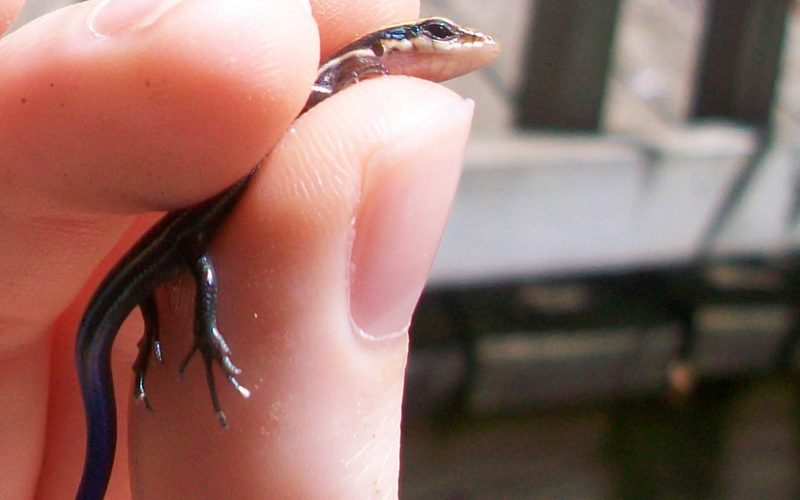
Staff Photo Amanda Bancroft
Five Lined Skinks are lizards native to North America. Juveniles are colorful enough to compete with a rainbow, and just as fleeting and difficult to catch.
By Amanda Bancroft
Now is the time to witness these humorously named, brilliantly colored, and overlooked reptiles scurrying about your patio or rock wall. The American five-lined skink, also called the blue-tailed skink or red-headed skink, is a lizard native to North America. Juveniles are colorful enough to compete with a rainbow, and just as fleeting and difficult to catch. When young, their tails are a brilliant blue, ranging in shades of green and yellow-orange up the body to the head, which is often slightly red or very red on males during the breeding season.
Adults are about twelve to twenty-one centimeters long, but newly hatched babies are about the size of your pinkie finger! Juveniles wear the classic five yellow or cream lines from their snout to their tails, but these fade with age, especially in males. They are sleek and slender, gliding easily around the leaf litter and occasionally scaling a tree to look for insects. Their diet helps control the insect population, such as caterpillars, ants, spiders, crickets, beetles and so on, but can include snails, smaller lizards, frogs and even newborn mice.
Their main supportive role in our native ecosystem could be termed “dinner.” They’re preyed on by raccoons, opossums, foxes, skunks, shrews, moles, snakes, and large birds like crows, kestrels and hawks. A common predator, however, is the cat – if you let your outdoor cat roam the yard, you may be disappointed when trying to find cute skink juveniles streaking by like rainbow lightning. They can live up to six years in the wild, but due to predation, rarely reach adulthood.
Their secret weapon is a detachable tail that twitches when released from the body, fooling predators into attacking the moving tail and leaving the skink to make a fast getaway. The tail does grow back, but is less colorful and not as long.
Skinks may be small, but males are endowed with two hemipenes. (Learn more at Life is Short but Snakes are Long: snakesarelong.blogspot.com) If they’re lucky enough to breed, females cooperate to guard ten to twenty tiny eggs in nests near one another. Females will protect and incubate the eggs, keeping them moist no matter what – even if they have to urinate on the eggs to prevent water loss! But just two days after hatching, mom departs forever.
The big downside to skinks, which is hardly noteworthy, is that they carry chiggers (just like many other common creatures) thus acting as host for these parasites to potentially find and bite us. However, in their preferred habitat of rocky areas for basking near moist deciduous forests with rotten logs and good cover, they do brighten things up while feeding a host of predators and keeping insects at bay. How many skinks can you count in your backyard?
Ripples is an emerging online educational center inspired by a holistic approach to making a difference. Follow our journey to live sustainably and make ripples with our lifestyle at: www.RipplesBlog.org.










